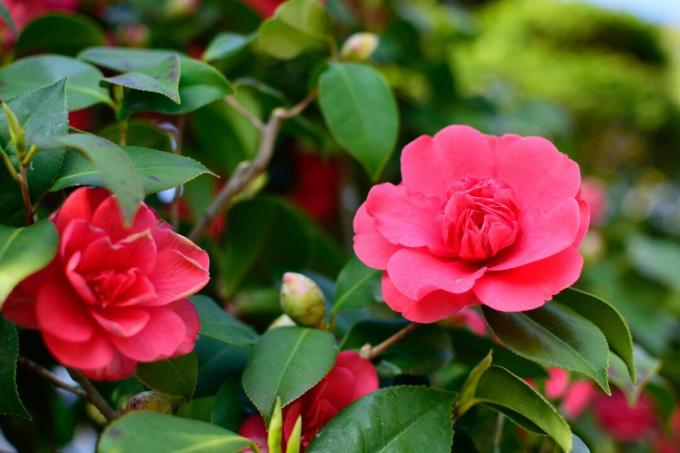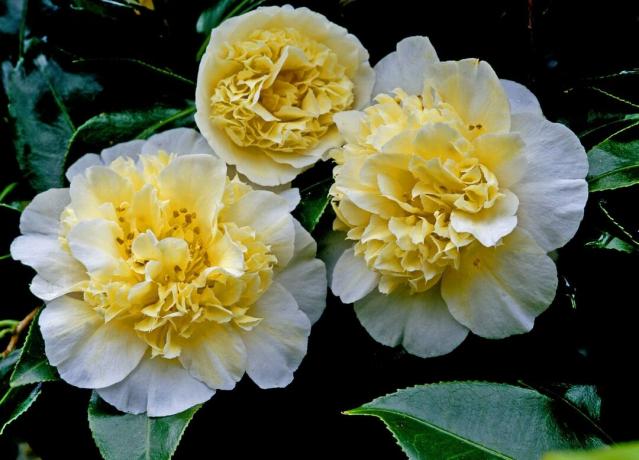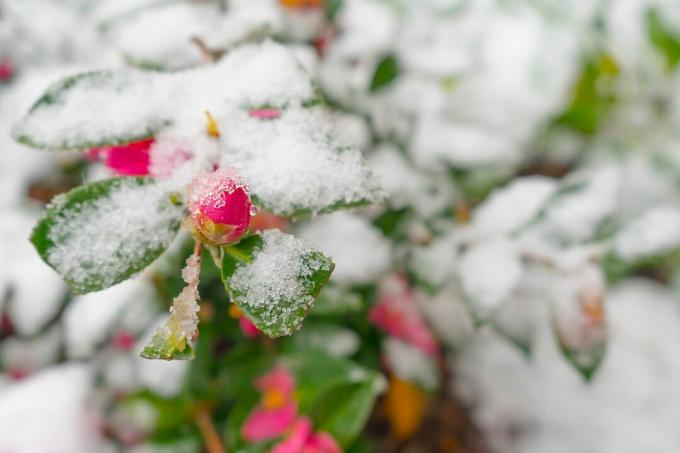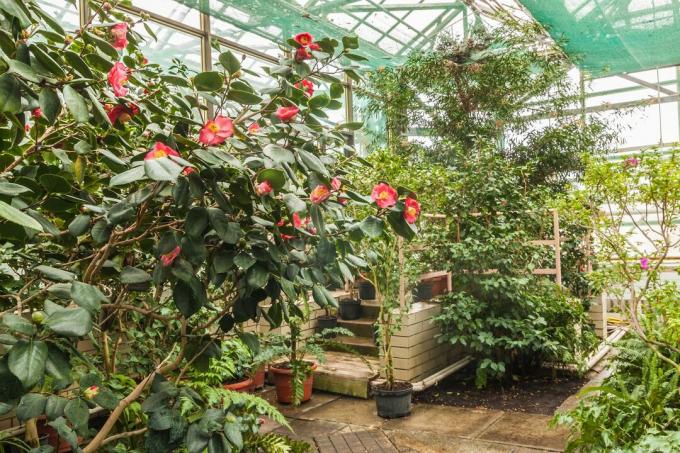The camellia is a beautiful and graceful ornamental plant. Everything you need to know about proper planting and care can be found here.

The camellia (Camellia) belongs to the tea bush family (Theaceae) and is popular with many gardeners because of the beauty of its lush and colorful flowers. In gardening circles, however, the prevailing opinion is that the camellia is difficult to keep. We will explain it to you and tell you how to bring the camellia to its full beauty.
contents
- Camellia: origin and meaning
- Camellia flowering period: when is the camellia flowering period?
- Camellia japonica and other camellia species
- Buy camellias
-
Planting camellias: location and substrate
- Location for camellias
- Camellias in pots: the right substrate
- Caring for camellias: properly water and fertilize
-
Repot camellias
- When to repot camellias?
- Cut camellias properly
-
Successfully overwintering camellias
- Are camellias hardy?
- Hibernate camellias properly in the pot
- Camellia diseases
Camellia: origin and meaning
According to tradition, the camellia was grown over 4000 years ago in what is now China. At that time the 'Chinese camellia' (Camellia sinensis) grown in order to obtain the green tea or the fermented black tea from its leaves. The camellia came to Europe at the beginning of the 16th century. Century and advanced from the 18th It became an extremely popular garden plant in the 20th century. The real reason for importing the plants was initially different. The Europeans wanted to make their own tea themselves. Knowing of the great economic importance that the camellia had for the Chinese, However, they often declared ornamental camellias as tea plants to avoid their monopoly on the tea market at the time to protect.

The camellia gained worldwide fame in 1848 when Alexandre Dumas published his novel The Lady of the Camellias. She received the accolade in 1853, when the story of the French writer was set to music in the opera "La Traviata" by Guiseppe Verdi. After a short peak, the camellia was quiet for a long time, not least due to the decline of the nobility, with whom the plant was particularly popular. Since the 1940s, however, the camellia has been attracting increased attention again. Today there are over 20,000 species, with flowering and winter hardiness being the decisive criteria when choosing the perfect variety for your own garden.
Camellia flowering period: when is the camellia flowering period?
The flowering time of the camellias depends on their location and how they are kept. Most species bloom outdoors between March and April. Potted plants show a somewhat broader temporal spectrum. Depending on the time of planting and the type or variety, the flowering time can vary between December and February.

Camellia japonica and other camellia species
According to experts, the camellia is represented with over 250 species worldwide. We will introduce you to some of the most popular species and describe the peculiarities of the Asian beauties.
Camellia japonica (Japanese camellia)
- Best known and most widespread wild camellia species; especially many cultivars of this kind available; unfortunately no hardy varieties; The color of the flowers varies from pink to yellow to brilliant white.

Camellia sasanqua (Scented camellia)
- Also many varieties available; autumn flowering camellia (from October); Flowers give off a light fragrance and can withstand a lot of sun; not hardy.

Camellia sinensis (Chinese camellia)
- Originally grown to make green and black tea; still have a high ornamental value; one of the oldest cultivated species with innumerable varieties.
In addition to the conventional varieties, there is now a wide range CamelliaHybrids. The new crossings offer innovative colors and shapes in many ways and are sometimes even a bit more robust when it comes to lower temperatures.

You can find more about the variety of the camellia world here in our detailed variety article with over 80 great varieties.
Buy camellias
Whether a plant thrives or not does not always depend on your performance as a hobby gardener. If a weakened or already diseased plant is bought, even the most intensive care can sometimes no longer help. Therefore, when buying, you should pay attention to the following:
- Lush green foliage and healthy buds
- Healthy and pronounced roots
- No traces of pests or diseases
- Sales location offers good location conditions
- Plants were cared for in a species-appropriate manner during rearing

Particularly recommended sources of supply for camellias we have here collected for you.
Planting camellias: location and substrate
Despite their poor winter hardiness, camellias are not houseplants - at least not all year round. We'll tell you how to use your Camellia can create particularly good conditions.
Location for camellias
Camellias thrive best in pots in a cool winter garden (between 13 and 16 ° C during flowering). If you want to plant your camellia outdoors, you should choose a sheltered location and be aware that a Excessive sunlight on the frozen leaves in winter can certainly damage or even death the plant can. Rather, the camellia prefers partially shaded locations. However, it is worthwhile to expose a camellia planted in a tub to the sun's rays more in summer to encourage bud formation.

Tip: Experts advise planting the camellia in spring. This means that you may skip the flowering in the first growth period, but the plant can establish itself well and will shine all the more colorful in the next year.
Camellias in pots: the right substrate
The camellia makes similar demands on the plant substrate as the rhododendron. A well-drained substrate that is slightly acidic works best here. Preferably use humus potting soil with a higher proportion of peat in order to meet the camellias' bog bed requirements.
Caring for camellias: properly water and fertilize
When it comes to care, the camellia makes relatively few demands on its owners if all the conditions are right. She is happy about regular watering. However, you should avoid waterlogging as much as possible, as this can quickly lead to root rot and mold growth. It is also necessary to fertilize your camellia regularly from late spring to late summer. So that you are not only doing your camellias a favor, but also Mother Earth in general, you should use a mainly organic organic fertilizer like our Plantura Organic universal fertilizer Select. This will be given to your loved ones in the form of a deposit. In this way the risk of over-fertilization is minimized and a long-term supply is promoted. You also support healthy soil life, which is particularly important in a spatially limited pot, and you also save valuable resources.
In addition to regular watering and fertilizing, high humidity also plays an important role so that your camellia can feel good all around. You can find out more about this in our special article Fertilizing camellias Experienced.
Tip: Make sure that the irrigation water is not too "hard", that is, not too calcareous, so that the acidic conditions in the plant substrate are not influenced too much. Rainwater is particularly suitable because it contains hardly any or no minerals.
More helpful information about the Caring for your camellia can be found here in our special article.
Repot camellias
The camellia's unusual life cycle is only one reason that they exhibit exceptionally strong root growth. You should therefore repot regularly so that your camellia can develop its magnificent flower pile every year.
When to repot camellias?
The perfect time for repotting cannot be determined in general. An important indicator that tells you it's time for a bigger bucket is roots emerging at the surface of the earth. This is a sign that the emerging roots have to give way to others in order to continue to get nutrients. Even regular fertilization and adequate watering cannot counteract this.
Cut camellias properly
Camellias usually rarely need to be pruned. Usually it is sufficient to remove the somewhat poorly developed wild shoots. Larger prunings are only recommended for older plants. However, you should make sure to spread the cut over several years so as not to deprive the plant of too large amounts of biomass all at once. In general, only cut off small parts of the shoots, as it can take a long time to sprout again. The best time for a camel cut is from May to July.

A detailed guide to the ideal Cut your camellia You will find here.
Successfully overwintering camellias
In order to enjoy your camellia for many years, you should set up suitable winter quarters for it. We will show you what is necessary for a successful wintering.
Are camellias hardy?
In general, camellias are not hardy. There have been reports of isolated successes in which camellias have endured temperatures as low as -15 ° C without losing their ability to flower. However, this is the absolute exception. However, you can influence the winter hardiness of the camellias a little by trying to create optimal external conditions.

The location should be protected from the wind and not be subject to major temperature fluctuations in winter. A place in partial shade is therefore ideal. In addition, an insulating layer of bark mulch, brushwood, leaves or similar material should protect the sensitive roots. Breeders are currently very interested in developing hardy varieties so that the camellias can enjoy us outdoors all year round.
Hibernate camellias properly in the pot
The camellia needs a resting phase of around eight weeks in winter if it is kept as a container plant. The temperature should be between 5 and 15 ° C and the humidity around 60%. The temperature should never rise above 15 ° C, otherwise the camellia may also begin to shed its buds in dry air.

Tip: Leave your camellia outside as long as possible in order to keep the phase of extreme change in conditions as short as possible.
More about the Wintering of the camellia as well as hardy varieties can be found here.
Camellia diseases
Unfortunately, your beloved camellias can also be attacked by a wide variety of pests and pathogens. These include animal pests such as scale insects or the black weevil, but also fungal pathogens.

Everything to the Camellia diseasesthat can affect your plant and how to control it successfully can be found here.
